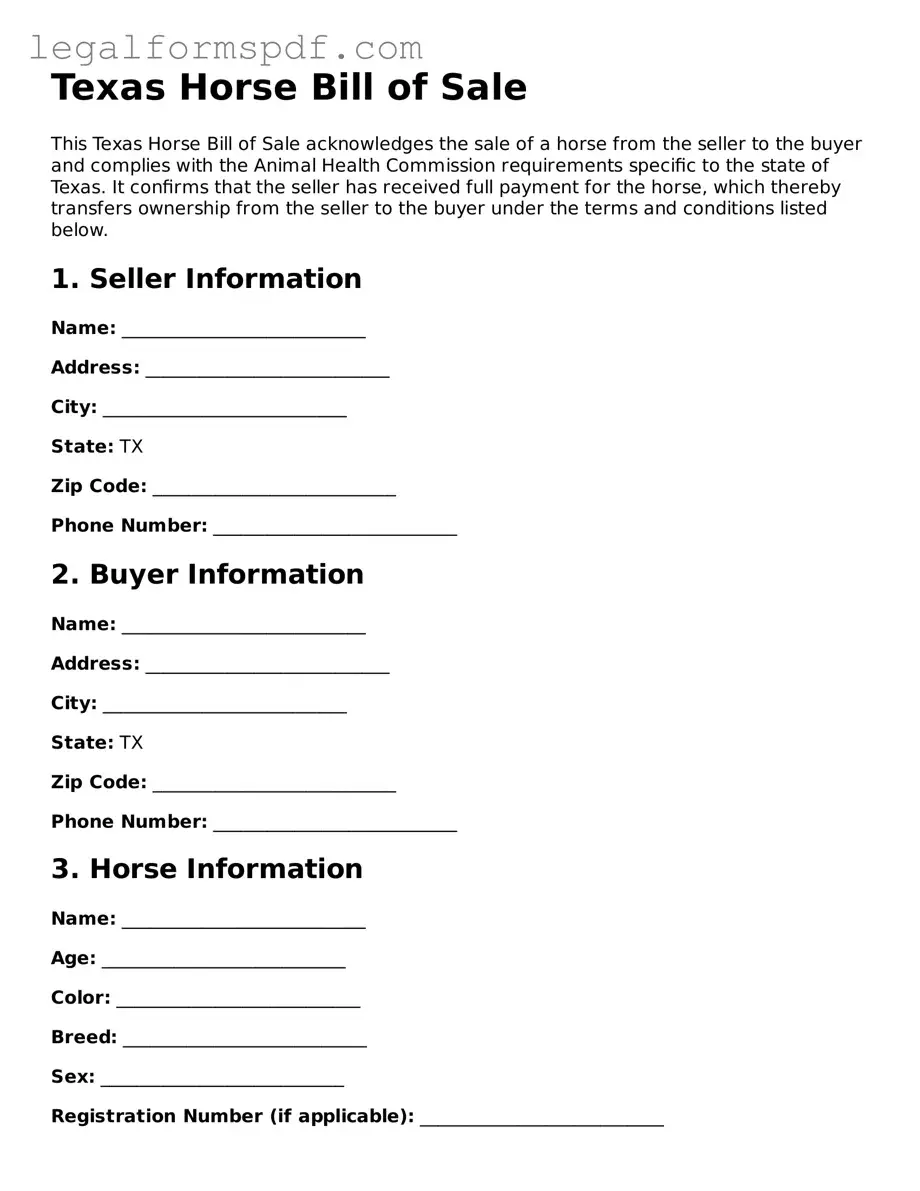The Texas Horse Bill of Sale form is closely related to the Vehicle Bill of Sale, commonly used during the sale of cars, motorcycles, and boats. Both documents serve as proof of purchase and transfer of ownership from seller to buyer. They typically include critical information such as the description of the item being sold (be it an animal or a vehicle), the sale price, and the date of sale. Both forms also require the signatures of both parties involved in the transaction to legitimize the agreement and often need to be notarized to add an extra layer of authenticity and legal protection.
Another document similar to the Texas Horse Bill of Sale form is the General Bill of Sale. This document is more versatile, covering the sale of various items aside from animals, like furniture, electronics, or other personal property. The General Bill of Sale serves the same primary purpose: to record the transaction details and transfer ownership from the seller to the buyer. Like the Horse Bill of Sale, it includes descriptions of the items being sold, the agreed-upon price, and both parties' signatures.
The Livestock Bill of Sale shares a specific similarity with the Texas Horse Bill of Sale form as it is also used in the sale of animals. However, the Livestock Bill of Sale can apply to various farm animals, including cows, pigs, sheep, and goats, not just horses. It ensures that information pertinent to the livestock, such as breed, age, and health status, is officially documented alongside the transaction’s financial and identification details.
Similar to the Texas Horse Bill of Sale, the Pet Bill of Sale is used for transactions involving animals; however, it focuses on pets like dogs, cats, birds, and exotic animals. This document proves ownership transfer and typically includes specifics about the pet, such as breed, date of birth, health information, and any other unique identifiers. Both the Pet and Horse Bills of Sale are designed to protect all parties involved in the transaction, ensuring clarity and responsibility regarding pet welfare.
The Equipment Bill of Sale is akin to the Texas Horse Bill of Sale but revolves around the purchase and sale of equipment, such as machinery, tools, or office supplies. While it serves a similar function in recording the sale and transferring ownership, the details included focus on the equipment's description, condition, serial number, and any warranties or disclaimers. This document is important for both individual and business transactions where equipment of significant value is exchanged.
The Firearm Bill of Sale, much like the Texas Horse Bill of Sale, is a legally binding document specifically designed for a certain type of property, in this case, firearms. It meticulously records the transfer of ownership of a gun from the seller to the buyer and includes detailed information such as make, model, caliber, and serial number, along with the sale price and the parties' signatures. This document is particularly important due to the legal regulations surrounding firearm ownership and transfer.
The Real Estate Bill of Sale, although related to the sale of property rather than animals, operates under a similar principle as the Texas Horse Bill of Sale. It is used to document the transaction between buyer and seller for the transfer of real estate ownership. While it deals with much more complex transactions, the core elements remain: a description of the property being sold, the agreed-upon price, and legally binding signatures. This document helps ensure clarity and legal standing for both parties in a real estate transaction.
The Artwork Bill of Sale is another document with purposes akin to the Texas Horse Bill of Sale, focusing on transactions involving pieces of art. It serves as a record of the sale and transfer of ownership of artwork between a seller and a buyer. Essential information such as the artwork's creator, title, medium, dimensions, and authenticity, alongside the sale price and the date of sale, are included. Both parties’ signatures on the document solidify the transaction and protect the interests of both the buyer and the artist or seller.
